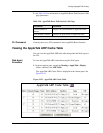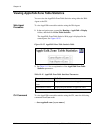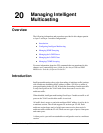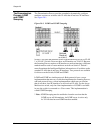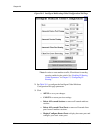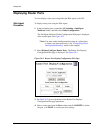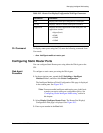
Document No. 10-300077, Issue 2 20-3
Managing Intelligent Multicasting
The Learning
Process, IGMP
Snooping
To learn which sessions must be configured, or which client or router ports
must be added or removed, a mechanism to draw that information from the
layer 3 protocols must be enabled. For the Avaya Multiservice Switch,
IGMP Snooping is that mechanism. IGMP Snooping can learn about
multicast sessions from IP interfaces that reside on the same switch.
* Note: IGMP Snooping is only available for VLANs that have an
IGMP interface enabled.
Enabling DVMRP on an interface also enables IGMP.
The
Administration
Process;
Management and
Pruning
At the core of all Intelligent Multicast functionality, the Administration
Process is manipulated by manual configuration and dynamic
configuration, and implements a pruning function. In a dynamically
configured environment, the Administration Process takes the information
from the Learning Process (from IGMP Snooping) or from one of the
clients in the Dissemination Process and creates the AFT table entries which
will perform the actual Intelligent Multicast functionality on the local
switch. It also passes the new information to the servers in the
Dissemination Process for distribution to other switches in the same VLAN.
The Administration Process views all data inputs as applications. Manual
configuration is the MGMT (management) application, IGMP Snooping is
the IGMP application, the LGMP client is the LGMP application, and the
CGMP snooper is the CGMP application.
The pruning functionality of the Administration Process is a cleanup facility
that prevents stale information from existing in the Intelligent Multicast
tables in the event an application fails to perform its own cleanup. There are
three types of pruning, each with their own timers: session, client port, and
router port.
Automatic Session Pruning, if enabled, will remove a session if that session
has not been active for Session Pruning Time.
Automatic Client Port Pruning, if enabled, will remove a client port from a
session if no IGMP reports have been received on that port for that session
in the time specified.
* Note: By enabling Automatic Client Port Pruning, there is a chance
that the switch may disrupt multicast service temporarily to
clients requesting to receive that multicast traffic. This is
because of the report suppression mechanism in IGMP v1 and
v2.
Automatic Router Port pruning, if enabled, will prune quiet router ports. If
the switch has not been notified that there is a router on the port in Router
Pruning Time, then the router port is removed.



